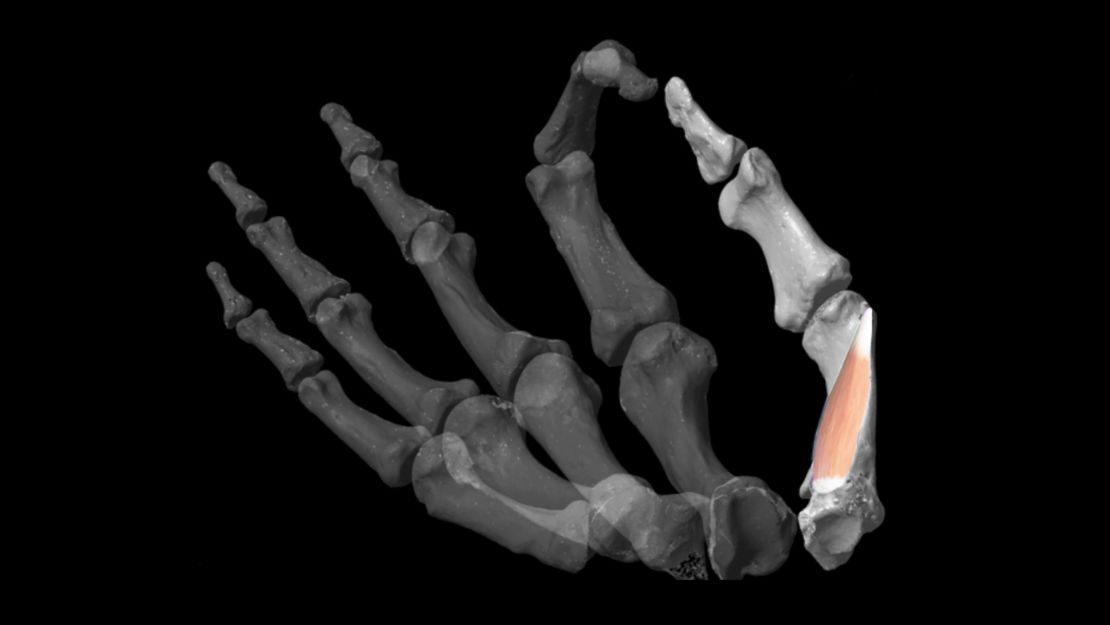Whether we’re texting or using tools, our hands – perhaps more than any other body part – are what equip us for modern life.
The killer app in the evolution of our hands was our opposable thumbs, which allow humans to precisely hold tiny things between our fingertips and pad of our thumb.
When did we first get this unusual manual dexterity?
It had been thought, based on comparisons of fossilized bones to modern human skeletons, that it may have emerged more than 3 million years ago when our earliest ancestors– theaustralopithecines such as the famous fossil Lucy – started using basic stone tools.
A new approach to this question, however, suggests that while early hominins may have been dexterous, they did not have the powerful thumb typical of humans today until later, about 2 million years ago. It was at this time an early species of humans first left Africa, and our dexterity could have been the driving force behind a more complex human culture that emerged then.
“Increased manual dexterity in the form of efficient thumb opposition was among the early defining characteristics of our lineage, providing a formidable adaptive advantage to our ancestors,” said paleoanthropologist Katerina Harvati, a professor at Eberhard Karls University of Tübingen in Germany and leadauthor of a new study that published in the journal Current Biology.
“It is likely a crucial element underlying the development of complex culture over the last 2 million years, shaping our biocultural evolution.”

The researchersestimated how powerful the thumb was in some of our fossil human relatives by virtually modeling a muscle in the thumb that is important for opposability and the motion that brings the thumb into contact with other fingers.
This involved comparing the grip of recent and early modern humans, living chimpanzees and six different hominin species.Those six species include one of the earliest – Australopithecus afarensis (Lucy) – and more recent archaic humans such as Neanderthals who existed before and, in some cases, alongside early Homo sapiens in the centuries and millennia before we emerged as the lone hominin survivor.
The scientists took into account soft tissue as well as bone anatomy.
“Until now manual dexterity has mainly been assessed by simply comparing the fossils with the anatomy present in humans, and assuming that the more anatomically similar a fossil was to the modern human condition, the more similar in its dexterity and manual capacities,” Harvati said via email.
“However, this view is relatively simplistic, as similar efficiency can be achieved by different forms, and also because it did not take into account the effect of muscles. The latter is extremely important, but of course is not preserved in the fossil record.”

The earliest stone tool makers from the Australopithecus family who lived from around 2 million to 3.8 million years ago did not have the heightened manual dexterity that later hominins did, the researchers found. It would have been more difficult to make precise movements such as holding a pen for writing, but these australopitchecines would have been able to use tools such as sticks and unmodified rocks – a bit like chimpanzees do in the wild.
“The phalanges (finger bones) of Australopithecine hands were generally longer and more curved than those of modern humans (though not as much as living great apes). So, they would probably be able to shake your hand, but it would likely make a noticeable difference,” Harvati said.
The researchers’results suggested that the powerful thumb that characterizes the human hand evolved only in some fossil hominin species around 2 million years ago.
At this time Homo erectus emerged – the earliest humans to have body proportions similar to Homo sapiens and the first to disperse from Africa – as well as evidence of systematic butchering of hunted animals and use of aquatic resources. Stone tools also got more sophisticated and were used more habitually, widening early human diets.
“Of course it is not possible to show a direct association,” Harvati said. “But we do see increased cultural complexity through time in the fossil record after 2 million years or so, which is the age of the earliest fossil showing heightened thumb efficiency in our sample.
“This includes more systematic use of stone tools, the gradual development of more complex stone tool industries, the gradual increased reliance on animal resources and, of course, the appearance of Homo erectus, a large brained and larger bodied hominin, whose geographic range expanded across Africa and Eurasia.”
The study also shed some light on Homo naledi – an enigmatic species of human relative first discovered in 2015 deep inside a cave system in South Africa.
Little is known about the life of this human relative, and no tools have been associated with this species. Its small brain and mix of modern and ancient anatomy has long flummoxed scientists. Homo naledi had a fairly powerful thumb and would have been able to make and use stone tools, this study suggested.
The study also found that Neanderthals and modern humans had a fairly similar levels of dexterity – suggesting it was inherited from a common ancestor.
Tracy Kivell, a professor at the University of Kent’s School of Anthropology and Conservation in the United Kingdom, who wasn’t involved in the research, said a lot of assumptions need to be made in this kind of analysis because muscles are not preserved in the fossil record. It can, however, provide some useful insights and new ideas to test, she said.
Kivell said the study authorsdid “an excellent job of dealing with all of the complexities involved in this kind of research to make their results as robust as possible.”
“Many primates are capable of precision and power grips. However, humans are capable for forceful pad-to-pad precision grips, for a which a powerful thumb is a critical component,” she said via email.
“It’s often thought that this ability in humans evolved in response to tool use. Being able to efficiently make and use tools (stone, bone, plant-based tools) would allow us to take advantage of new dietary resources that would otherwise be unavailable or take more time/energy to access.”






